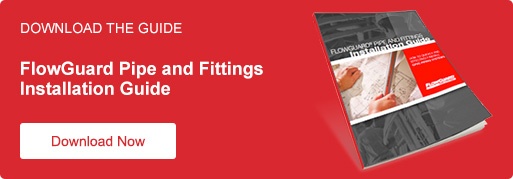Solvent Cement Success – It’s Math and Science in Seven Steps
Experienced installers of FlowGuard® CPVC pipe and fittings for plumbing and HVAC projects know: a high standard of workmanship in the joining method depends on following the directions for solvent cement welding to the letter.
Solvent welding is a form of joining that combines principles of geometry and chemistry rather than heat. When the right mixture of solvents and radial pressure is applied, a CPVC pipe and its suitable fitting become permanently fused and form a joint that functions as a single component. In a properly assembled system made of FlowGuard CPVC, 80% of the joint strength will come from this fused area.
Solvent cement is made up of CPVC resin, stabilizers and fillers in a variety of solvents; it is not a glue. The material works by softening the topmost layers of the CPVC pipe and fittings, curing as the CPVC molecules harden, form an inextricable bond that is 80% of the strength of the joint, and the solvent flashes off completely.
Installers must avoid angled pipe cuts, clear away burrs and filings, and verify a proper interference fit prior to solvent welding. There can be no shortcuts at the beginning of the process, or the resiliency of the installation is compromised before the solvent cement can work its magic. There are just seven steps from cutting the pipe to pressure testing the system, and any well-trained installer can easily master them.
- Squarely cut the pipe to the desired length to provide the maximum surface for a strong bond.
- Deburr and bevel the pipe.
- Prepare a proper interference fit by inserting the pipe 1/3 – 2/3 of the depth into the fitting.
- Apply the solvent cement evenly and in the exact manner recommended by the manufacturer.
- Assemble the pipe and fitting quickly but firmly to prevent pipe push-out.
- Allow the pipe to cure, again according to recommendations of the solvent cement manufacturer.
- Test the piping system.
FlowGuard CPVC pipe and fittings are the most established and top performing polymer piping products for hot and cold water plumbing systems in the market. If you’re new to installing CPVC pipe and solvent cement welding, but want to consider it for your next job, confidence is within arm’s reach.
Contact a FlowGuard technical expert today, and read our FlowGuard Pipe and Fittings Installation Guide for more on the basics of these steps. In addition, you will find guidance on accounting for thermal expansion; transitioning from CPVC to other metal materials; handling and storage; and requirements for hangers and supports and water heater hookups.
.png)
-1.png)
